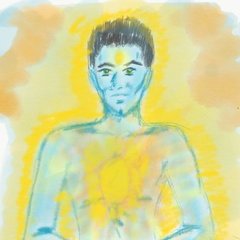-
Content count
8,286 -
Joined
-
Last visited
-
Days Won
70
Everything posted by dwai
-
Tripura Rahasya has a very nice chapter on different types of jnanis. I have quoted from it on the “continuous samadhi” thread. There is no one-size-fits all, in that, after realization, there is no homogenization of the “individual”.
-
One of my earlier practices was to meditate on the space between thoughts. Very interesting experience when this “clicked” for me was when one day after asana practice I lay down in corpse pose and the mental chatter started flowing and then floated to the surface and a luminous clarity became apparent underlying the chatter, like a majestic river on which debris was floating. BTW what is the 5th jhana? Thanks for pointing out “not belonging to a self” - it was a point I intended to make but promptly forgot
-
I agree with Thrangu Rinpoche and Hui Neng, FWIW There is continuous samadhi interrupted by thoughts - only a few are able to recognize this. Given that, there is no need to try and eliminate thoughts - just not grasping is sufficient.
-
And just because I can, I will add a 3rd part to this "puzzle" - Dzogchen. Some food for thought provided below - Practice Potential Benefits How it Could Support Other Practices Zuowang * Cultivating stillness and presence. * Provides a foundation for Dzogchen's direct pointing-out instructions. * Releasing mental fixations. * Creates mental pliancy for deeper Vedantic contemplation in Nidhidhyasana. Dzogchen * Direct experiences of rigpa (pure awareness). * Validates the non-dual insights suggested in Vedanta and Daoism. * Profound understanding of emptiness. * Helps cut through conceptual clinging during Nidhidhyasana and Zuowang. Nidhidhyasana * Strengthening intellectual clarity of Advaita concepts, direct realization of Self/True Nature. * Provides a conceptual map to understand experiences in Zuowang and Dzogchen. * Removing deep-seated doubts about the true Self. * Supports letting go in Zuowang, and solidifies the confidence in Dzogchen's realization.
-
Please elaborate if you can - we're interested.
-
For those who might be interested - this kind of reading and meditating on the contents of such texts is considered AV meditation (aka nidhidhyasana). In fact, texts like Ashtavakra Gita, Tripura Rahasya, Yoga Vashishta are considered Nidhidhyasana texts.
-
This reminds me of another thread from another time -
-
It depends on the purpose of said methods. AV doesn't subscribe to the view that the individual has to transform into something else. You are already the Absolute Reality, even if you don't know it yet. The problem is ignorance, so the solution is knowledge (as a direct realization of the Truth). If the alchemical methods will help you focus your mind and remove its impurities; by all means, try them. The problem with alchemical methods is that they have tended to have purported objectives such as creating a "rainbow body" or transforming into something more significant—meaning something that you are not today but will become in the future. That perspective is erroneous and will divert the seeker from realizing their true nature and venture into what can be called "immortality projects" - which add to the ignorance that veils our true nature from us, therefore exacerbating the primary problem.
-
PS—The approach used, and its teachings are correlated with the Upanishads. For example, the Madukya Upanishad employs the Avastha-traya viveka approach (Waking/Dreaming/Deep Sleep). Usually the teacher will temper their teaching based on their student evaluation (for some a single approach will work, for others multiple approaches might be needed). Additionally, there is also the prospect of a student not being ready for this kind of inquiry—they might have what is called "chitta mala" (impurities in their mind) or "chitta viskepa" (scattered mind). Different techniques are recommended to remedy these as preliminary steps (which might include yogic meditation, hatha yoga, service, mantras, etc.). Once the mind is sufficiently purified, then the teachings of Vedanta will be absorbed properly.
-
Advaita Vedanta is the Non-Dual teaching contained in Vedanta (aka Upanishads). Advaita Vedanta posits that this (material world) is transitory—constantly changing. But underlying this, there is a changeless reality—which is Existence itself, Consciousness/Awareness itself, and bliss itself. Furthermore, you—the limited being who seems to live and die and suffer in the process—are none other than that changeless reality. There is no need for major alchemical processes to transform the individual from a limited being to anything else—you are that changeless infinite awareness right here and now, only that you have forgotten it due to conditioning (society, experiences, etc.). All you need is someone to point you to yourself and help you realize your true nature. Once you realize your true nature, all your suffering, cravings, and aversions will fall away, and you can become free. What does one practice in Advaita Vedanta? There are 3 main processes - 1. Listening (sravana) 2. Contemplating (manana) 3. Meditating (nidhidhyasana) How does one accomplish these processes? 1. Listening - find a realized teacher and listen to their teachings 2. contemplating - Take the teachings you're listening to and contemplate on them - how they relate to you, how you are able to analyze your own experiences to confirm empirically the teachings. In this, there are several approaches (called vicharas or analyses) where you use apply the teachings to separate the real from the unreal (viveka) depending on which one is given to you by your teacher - - The Analysis of the Five Sheaths (panchakosha viveka) - The Analysis of the Seer and the Seen (Drik-Drishya viveka) - The Analysis of Waking, Dreaming and Deep Sleep (avastha-traya viveka) 3. Meditating - Integrate the experiential knowledge you develop as you proceed through the first two steps into a continuous meditation on the nature of reality (not the same kind of meditation as yogic meditation)
-
Depends on what you want to learn There are several methods/practices of inquiry in different Upanishads. Start with the Mandukya Upanishad if you’re feeling lucky. It covers what is called the avasthatraya method - and goes into a deep exploration of Om.
-
I started in the old-school karate Goju Ryu style back in the 1990s. I trained in Hapkido and Aikido for a few years when I moved to the US. I also started learning Taichi around that time (back in 2000), and eventually, I dropped all hard martial arts. I stuck with Taichi (initially Yang style and then Temple style in the system of Master Waysun Liao—which is what I continue to practice to this day).
-
The mantra Om is basically a method of this inward collecting process. Om comprises of three syllables and the fourth part being silence - A, U, M (pronounced in Sanskrit as aah, ooh, mmm ). It is a model of the everything (aah) collapsing (ooh) into a singularity (mmm), and then silence/stillness/emptiness. A represents the material universe, U represents the process of returning/reversion, M represents the singularity and silence is emptiness.
-
It says a lot more about people who spout off without adequate knowledge on the matter of Advaita Vedanta Advaita Vedanta is the teachings contained in the Upanishads - which are part of the Vedic canon.
-
The big question is, is this literally light or figurative light? We can see “light” - in Sanskrit it is called bhāti (shining), in all phenomena right here and now. There are five aspects of all phenomena/things - * asti - is-ness * bhāti - shining * priyam - usefulness (even a heap of dung is useful) * nāma - name * rūpa - form Of these, the last two are categorized as jagadrūpam (sign of the materialistic world) and the first three are called brahmarūpam (sign of Brahaman). What people miss is the brahmarūpam aspects (in which the shining/light belongs) and only recognize the jagadrūpam aspects. What happens after realization is the brahmarūpam also becomes recognized, hence “seeing light in everything, including within. Can it manifest as perceptible light for some? Maybe. People with synesthesia see colors associated with sounds, patterns with music and so on.
-
Know or know not, try we must 😇
-

What's with this Relative and Absolute Reality dichotomy? It is all very confusing...
dwai replied to dwai's topic in General Discussion
This is akin to how before one knows what a mirage is, it is mistaken for water. Once it becomes known what a mirage is, a mirage still appears to be a body of water from the distance, but one understands it is just a mirage. -
The dharma traditions use a 2-truth Reality to reconcile True Nature, which is changeless (or empty depending on the specific path within the dharma family), and the manifest world of phenomena hinged on change. The model states as follows - There is an absolute reality which is beyond all categories and labels, names and forms, and is ever free, and is beyond space and time (and therefore change). This is our True Nature - pure consciousness. It is existence itself, it is being itself, it is peace/bliss itself. There is a phenomenal world, in which beings (such as you and me) come into existence, live out their lives, and die. This is the world of change - there is nothing permanent about this world except change itself. This is called the Relative Reality. How then can one reconcile the two? If one is true, the other must be false, right? Can there actually be two truths? The confusion is because we operate in this phenomenal world, and that which is called Absolute Reality isn't apparent at all. So, when we experience all phenomena (basically anything that is subject to change, has a beginning and end is called a phenomenon) - we can't really find anything changeless there. The confusion occurs as a consequence of looking for a "thing". Absolute Reality is not a thing. How then can one recognize/realize this Absolute Reality? (more later)
-

The Value of Encountering Life's Challenges Along the Spiritual Path
dwai replied to Small Fur's topic in General Discussion
It is ever-present, but sadly overlooked because people always look for some object to latch onto. It’s like the absentminded person who’s wearing his glasses and looking for it outside somewhere…how do you know you have eyes?- 4 replies
-
- 1
-

-
- refining shen
- karma
-
(and 4 more)
Tagged with:
-
From James Swartz There are so many ways to explain this - but it requires a truly open mind to understand/realize. If one’s mind is preoccupied by concepts and ideas, then it cannot truly accept the knowledge (indirect though it may be). If it cannot accept the knowledge, how can it realize?
-
What soul?
-
It is not the I AM, but awareness enveloped in inertia. That which you call “unknown” is the I AM.
-
all beings are already enlightened - they just haven’t realized it yet
-

What's with this Relative and Absolute Reality dichotomy? It is all very confusing...
dwai replied to dwai's topic in General Discussion
Kshanikam - Momentary Sarvam - Everything So the Buddhists say - "Everything is momentary" (impermanence) Khalu - Verify idam - This Brahma - Brahman (the ground of being) Advaitins say - "Everything is verily Brahman" (Permanence) The two seem mutually exclusive. But are they? Everything is certainly momentary/temporary, but does that mean Brahman is also fleeting and temporary? This can be understood by the statement, "Samsara (everything) is Nirvana (liberation), and Nirvana (liberation) is Samsara (everything)." The Advaitins say that "everything" is perceived as separate, ephemeral objects because the knowledge of Brahman (Pure Consciousness) is not realized. When the realization occurs that all things appear and disappear in Brahman alone, then the confusion is dispelled once and for all.




